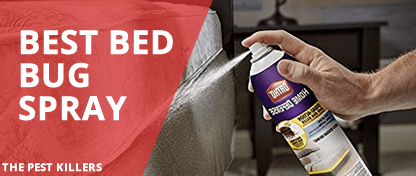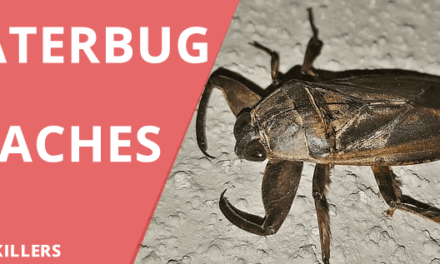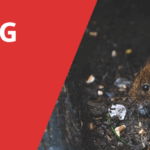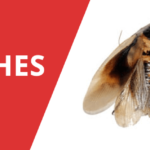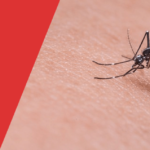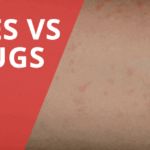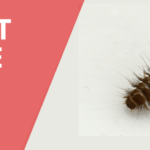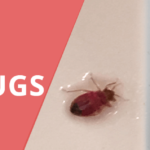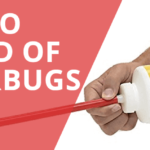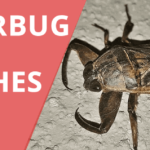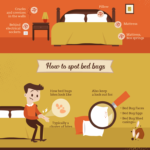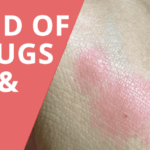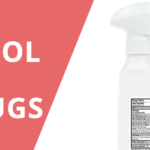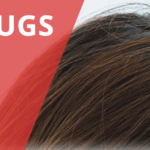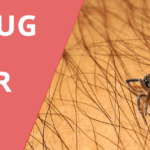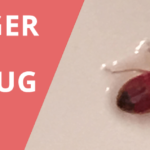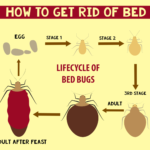Note: Bed bug and scabies bites are two different outbreaks. While a professional exterminator can treat the former, the latter would require immediate medical assistance.
Experiencing red welts and itchy skin is not the best feeling. What makes it worse, is not knowing what is causing this irritation.
Scabies and Bed Bug bites cause itchy rashes that worsen at night, and both are equally problematic and irritating. However, before you work on getting rid of the symptoms and eliminating the insect, you must first be able to identify whether bed bugs or scabies have infested you.
What are scabies?
 Contrary to what many believe, scabies is not an infection. In fact, it is an infestation. Tiny mites (called Sarcoptes scabiei) take up residence in the outer layers of the skin. Since each mite measures less than half a millimeter in length, spotting one with the naked eye is quite tricky.
Contrary to what many believe, scabies is not an infection. In fact, it is an infestation. Tiny mites (called Sarcoptes scabiei) take up residence in the outer layers of the skin. Since each mite measures less than half a millimeter in length, spotting one with the naked eye is quite tricky.
To the naked eye, these mites just might seem like small black dots on the skin. However, under a microscope, these appear to be round in shape with eight legs. A microscope can also identify the mites, fecal matter, and eggs from skin scrapings.
Photo Credit: By Steschke
While many people believe that the reason behind their itchy rashes on their skin is due to bed bugs, the truth is, the rashes could also be because of a microscopic bug, known as scabies.
However, there is a clear difference between the appearance of the rashes and bite marks. Primarily, both the insects feed on human blood. However, while bed bugs feed on the outside, scabies mites burrow themselves inside the skin.
Where do scabies live?
Similar to ticks, female mites burrow themselves under the skin’s uppermost layer to feed on blood and lay eggs. While doing so, these mites leave behind track-like burrows in the skin that appear as raised lines that are either skin-colored or grayish-white accompanied by red bumps. These burrows can measure anywhere from 3 millimeters to 10 millimeters and have a very small papule at the open end.
Since the skin reacts adversely to any invasion, you experience a rash. As the mites continue to burrow and lay eggs, the infestation grows and eventually leads to an angry rash and relentless itching.
While scabies can be found anywhere on the body, they are most commonly spotted between the fingers, in armpits and toenails, around the navel and waistline, the folds of the knee, elbow, and wrist, and on the genitals or breasts. At any given time, people with only scabies carry around 10 to 15 mites.
In young children, these mites are found on the soles, palms, head, face, and neck.
What are Bed Bugs?

Bedbugs are small, oval-shaped insects that feed on the blood from animals and humans. Bed bugs cannot fly and measure 5 millimeters to 7 millimeters in length.
Once they infest your home, you’ll find bedbugs anywhere. They can live in different types of textiles, cracks in the furniture, and even in upholstered furniture. However, most commonly they are found in bed frames, box springs, and in the mattress.
These pesky bugs are most commonly active at night and tend to bite any exposed skin while the individual is sleeping. They usually bite the arms, hands, neck, and the face. The bite is generally painless and is not really noticed. In fact, the bite may also be mistaken for a rash caused by something else. The bites appear as small, raised, or bumps on the skin accompanied by symptoms like itching, redness, and swelling.
Scabies vs. Bedbugs – Main Difference
| Scabies | Bed Bug |
|
|---|---|---|
| Appearance / Classification Type | Human itch mite (microscopic) | Parasites belonging to the Climex species |
| Infestation Areas | Finger nails, armpits waistline, toenails, groin area | Furniture, sofas, cracks, and crevices, bedding |
| Exposure | Human contact, environment | Spread mostly via secondhand furniture and luggage from the time spent in a hotel |
| Bite Appearance / Symptoms | Grayish-white burrow that may carry a disease | Multiple bites around body in clusters of two or three |
| Treatment | Seek medical assistance | Eradication |
While both the insects feed on your blood, there are major differences. Primarily, bed bugs feed on blood externally, while scabies burrow underneath the skin to live and suck blood. Both the insects can be identified based on their appearance and bites.
Scabies vs Bed Bugs – Appearance
Bed bugs are small in size, and this size helps them to hide in cracks and crevices. However, you can still spot these insects without using a microscope. On the other hand, scabies is microscopic parasites that are hardly visible to the naked eye and would appear as black dots at best.
Scabies vs Bed Bugs Bites

Bites from bed bugs are characterized by flat and raised red-colored welts. These usually appear in a cluster of two to three bites. On the other hand, checking for a single scabies bite is quite difficult. These bites occur as burrows with raised lines and are grayish-white in color. With time, these turn into inflamed and red bumps.
Bed bugs tend to bite exposed skin while the victim is sleeping. Bed bites particularly bite in places where the bed sheet or the mattress meet the body surface. Therefore, the bites are highly concentrated around the face, back, arms, shoulders, and legs. Meanwhile, scabies loves to dig into the moist and folds of the skin which is why you’ll find bites in sensitive areas, around the waist, between the toes and fingers, or in the armpits.
Bites by bed bug start to itch after one to two days of the initial bite. In some cases, it might take some weeks for the itching to surface. On the flip side, if you have scabies for the first time, there you will observe the symptoms of the bite such as itching and rashes two to six weeks after exposure. However, if you become a victim of re-infestation, then it might only take up to four days for the itching and swelling to occur.
Symptoms of bites
While bites from both bed bugs and scabies are itchy, other symptoms can help you pinpoint the cause of the bite.
Scabies Symptoms
- Scabies often occurs with various skin eruptions. These include:
- Burrows: Burrows is the easiest way to recognize scabies. These characteristic lesions are made by adult female mites so that they can lay eggs under the skin. However, they might not always occur.
- Excoriations
- Crusting of the skin
- Itchy bumps or nodules in the groin or armpits
- Red and scaly patches
- Rashes look like pimples or blisters. They are pink-colored raised bumps that have a liquid-filled clear top.
- In babies, the scabies rashes can develop into lesions, urticarial, papules, etc.
Bedbugs Symptoms
Individuals often don’t develop any symptoms to bed bug bites. However, some are allergic to the protein present in the bugs’ saliva, thus resulting in the development of the following symptoms:
- Itchy, red-colored welts on the skin
- The bitten area appears swollen with the epicenter of the bite surrounded by a red halo
- Bites appear in a linear pattern and can get extremely itchy at times
Prevention of Bites – How to Handle an Infestation
Before you treat yourself, you must know how to handle a bedbug and a scabies infestation so that it does not reoccur once you are on the road to recovery.
Scabies Prevention

To avoid scabies, you need to avoid making direct skin-to-skin contact with an infected person or using the items of the infected individuals such as bedding or clothing. Moreover, the treatment of scabies is recommended for all the members of the house, particularly to those that have had prolonged skin on skin contact. Treating all potentially exposed persons helps prevent re-infestation and re-exposure.
Both clothing and bedding that has come into contact during the three days before the start of treatment must also be machine washed and dried with hot water and hot dryer cycles. Or they can also be dry cleaned. Meanwhile, items that can’t be laundered or dry-cleaned must be stored in a closed plastic bag for at least three to four days. Scabies mites are typically unable to survive for more than three days away from the skin.
The room of a patient diagnosed with crusted scabies must be rigorously cleaned and vacuumed. Environmental disinfestation with pesticide fogs or sprays is not only unnecessary but is discouraged as well.
Bed bugs Prevention
Inspect all used couches, beds, and furniture for signs of bed bugs before you bring them home.
Make use of a protective cover that encases both the box springs as well as mattresses to cover up many hiding spots of these bugs. Plus, the encasement’s light color makes it easy to see the bed bugs. Make sure you purchase a high-quality encasement that is resistant to tearing. Frequently check the encasement for holes.
Remove the clutter from your house in order to eliminate the hiding places for these bugs. Make sure you regularly vacuum to remove hitchhikers too.
Be extra careful when using shared laundry facilities. Put the items that must be washed in plastic bags and remove the clothes directly from the dryer into the bag and fold them at home to reduce the chances of catching bed bugs.
In case you live in a multi-family home, you should try to isolate your unit. This can be done by:
- Getting door sweeps installed on the bottom of the doors to discourage the bugs’ movement into hallways
- Sealing the crevices and cracks around light sockets, baseboards, etc. to discourage the bugs’ movement through wall voids
Scabies treatment
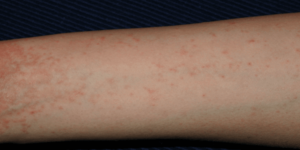 Treating scabies involves more than just cleaning your house. It also involves taking medicines.
Treating scabies involves more than just cleaning your house. It also involves taking medicines.
For most people, medicine applied to the skin can cure scabies. Such creams are applied to the whole skin from the neck down. Meanwhile, young children and infants need to get treatment for their face and scalp as well.
The medicine is usually applied at bedtime and washed off once the patient wakes up. The process must be repeated after one week as well. Medicines prescribed by scabies include:
1% lindane lotion – used when all other treatment options fail to work
- 5% permethrin cream – this kills the scabies mites and eggs
- 5-10% sulfur ointment – used in people that can’t use the other treatment options
- 10% crotamiton cream – lotion based medicine that helps to kill the mites
To get rid of itching, your dermatologist may prescribe antihistamines and will recommend you to keep your skin cool by soaking it in cold water.
Widespread as well as crusted scabies usually needs stronger medicine. Therefore, patients with such kinds of scabies might be prescribed ivermectin. While some patients might only need one dose, some may also need to take two to three doses to get rid of scabies. Similarly, ivermectin pills are taken once every two weeks.
Treating bed bugs
Of course, cleaning up the infested areas is helpful for controlling bedbugs, however, getting rid of bed bugs completely also requires chemical treatments. Since treating your bedroom, as well as your furniture with insecticides, may be harmful, you must use such bed bug sprays that can be safely used in bedrooms.
Make sure you don’t treat bedding and mattresses unless the label specifies that you can use the product on bedding.
Generally, it is not only effective, but also safe to hire a pest control expert for extermination for bedbugs.
As far as treating bedbug bites goes, your dermatologist will prescribe you prescriptions to tone down the itching and swelling. You can also use home remedies such as tea tree oil to reduce the rashes and swelling.
Scabies vs Bed bugs – Wrapping Up
After spotting a rash on your skin, you might be compelled to think that it might be because of bed bugs. However, before you start any treatment, make sure to look at the rash closely and see if it looks like a burrow or a cluster of pimples. Similarly, check your bedding and furniture to confirm if bedbugs or scabies have infested you. Finally, make sure to seek medical assistance from a doctor to help treat the rash and clean up your space to get rid of these pests.


